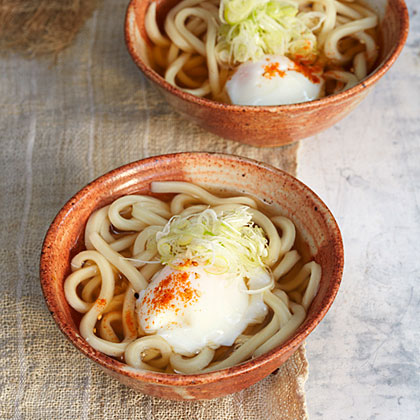Udon with Soft Egg and Green Onion (Onsen Tamago Udon)

How to Make It
Try this method for custardlike eggs, based on a Japanese tradition of cooking them in an outdoor hot spring: Heat a large pot of water to 160°. Gently lower eggs into water and simmer 30 minutes, keeping water temperature between 152° and 156° (add a tablespoon of ice water to control the heat's rise). Chill eggs in cold water, then carefully crack into a small, shallow dish. Or soft-cook eggs the way you like.
Boil udon (see "Udon Essentials," below). Using a large strainer, scoop out noodles into a large bowl and save water to heat soup bowls.
Meanwhile, put green onions in a bowl of cold water and vigorously swish around with your fingers to separate into rings. Drain; repeat twice.
Bring broth to a boil in a saucepan.
Warm 4 soup bowls by dipping them in hot udon-cooking water. Divide noodles among bowls. Scoop an egg into each, leaving behind most of white, and ladle broth over noodles. Top with green onions and a pinch of seven-spice powder.
Udon Essentials Udon (wheat-flour noodles): Store-bought fresh-frozen noodles have a supple texture that's closest to homemade, while the dried ones tend to be thin and flabby. To cook store-bought fresh-frozen udon, drop the frozen block into boiling water. When the water boils again, drain. Cook udon right before serving; the noodles get sticky as they sit.
Make ahead: Eggs in shell, up to 2 days, chilled. Green onions, up to 1 day, chilled.
Ingredients
Directions
Try this method for custardlike eggs, based on a Japanese tradition of cooking them in an outdoor hot spring: Heat a large pot of water to 160°. Gently lower eggs into water and simmer 30 minutes, keeping water temperature between 152° and 156° (add a tablespoon of ice water to control the heat's rise). Chill eggs in cold water, then carefully crack into a small, shallow dish. Or soft-cook eggs the way you like.
Boil udon (see "Udon Essentials," below). Using a large strainer, scoop out noodles into a large bowl and save water to heat soup bowls.
Meanwhile, put green onions in a bowl of cold water and vigorously swish around with your fingers to separate into rings. Drain; repeat twice.
Bring broth to a boil in a saucepan.
Warm 4 soup bowls by dipping them in hot udon-cooking water. Divide noodles among bowls. Scoop an egg into each, leaving behind most of white, and ladle broth over noodles. Top with green onions and a pinch of seven-spice powder.
Udon Essentials Udon (wheat-flour noodles): Store-bought fresh-frozen noodles have a supple texture that's closest to homemade, while the dried ones tend to be thin and flabby. To cook store-bought fresh-frozen udon, drop the frozen block into boiling water. When the water boils again, drain. Cook udon right before serving; the noodles get sticky as they sit.
Make ahead: Eggs in shell, up to 2 days, chilled. Green onions, up to 1 day, chilled.

